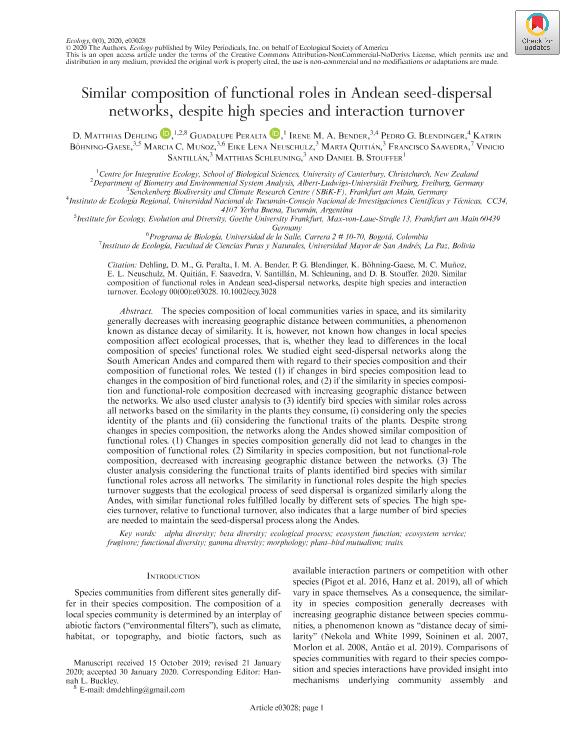Mostrar el registro sencillo del ítem
dc.contributor.author
Dehling, D. Matthias
dc.contributor.author
Peralta, Guadalupe

dc.contributor.author
Bender, Irene Maria Antoinetta

dc.contributor.author
Blendinger, Pedro Gerardo

dc.contributor.author
Böhning Gaese, Katrin
dc.contributor.author
Muñoz, Marcia C.
dc.contributor.author
Neuschulz, Eike Lena
dc.contributor.author
Quitián, Marta
dc.contributor.author
Saavedra, Francisco
dc.contributor.author
Santillán, Vinicio
dc.contributor.author
Schleuning, Matthias
dc.contributor.author
Stouffer, Daniel B.
dc.date.available
2021-11-12T18:03:42Z
dc.date.issued
2020-02-29
dc.identifier.citation
Dehling, D. Matthias; Peralta, Guadalupe; Bender, Irene Maria Antoinetta; Blendinger, Pedro Gerardo; Böhning Gaese, Katrin; et al.; Similar composition of functional roles in Andean seed-dispersal networks, despite high species and interaction turnover; Ecological Society of America; Ecology; 101; 7; 29-2-2020; 1-11
dc.identifier.issn
0012-9658
dc.identifier.uri
http://hdl.handle.net/11336/146806
dc.description.abstract
The species composition of local communities varies in space, and its similarity generally decreases with increasing geographic distance between communities, a phenomenon known as distance decay of similarity. It is, however, not known how changes in local species composition affect ecological processes, that is, whether they lead to differences in the local composition of species' functional roles. We studied eight seed-dispersal networks along the South American Andes and compared them with regard to their species composition and their composition of functional roles. We tested (1) if changes in bird species composition lead to changes in the composition of bird functional roles, and (2) if the similarity in species composition and functional-role composition decreased with increasing geographic distance between the networks. We also used cluster analysis to (3) identify bird species with similar roles across all networks based on the similarity in the plants they consume, (i) considering only the species identity of the plants and (ii) considering the functional traits of the plants. Despite strong changes in species composition, the networks along the Andes showed similar composition of functional roles. (1) Changes in species composition generally did not lead to changes in the composition of functional roles. (2) Similarity in species composition, but not functional-role composition, decreased with increasing geographic distance between the networks. (3) The cluster analysis considering the functional traits of plants identified bird species with similar functional roles across all networks. The similarity in functional roles despite the high species turnover suggests that the ecological process of seed dispersal is organized similarly along the Andes, with similar functional roles fulfilled locally by different sets of species. The high species turnover, relative to functional turnover, also indicates that a large number of bird species are needed to maintain the seed-dispersal process along the Andes.
dc.format
application/pdf
dc.language.iso
eng
dc.publisher
Ecological Society of America

dc.rights
info:eu-repo/semantics/openAccess
dc.rights.uri
https://creativecommons.org/licenses/by-nc-nd/2.5/ar/
dc.subject
ALPHA DIVERSITY
dc.subject
BETA DIVERSITY
dc.subject
ECOLOGICAL PROCESS
dc.subject
ECOSYSTEM FUNCTION
dc.subject
ECOSYSTEM SERVICE
dc.subject
FRUGIVORE
dc.subject
FUNCTIONAL DIVERSITY
dc.subject
GAMMA DIVERSITY
dc.subject
MORPHOLOGY
dc.subject
PLANT–BIRD MUTUALISM
dc.subject
TRAITS
dc.subject.classification
Ecología

dc.subject.classification
Ciencias Biológicas

dc.subject.classification
CIENCIAS NATURALES Y EXACTAS

dc.title
Similar composition of functional roles in Andean seed-dispersal networks, despite high species and interaction turnover
dc.type
info:eu-repo/semantics/article
dc.type
info:ar-repo/semantics/artículo
dc.type
info:eu-repo/semantics/publishedVersion
dc.date.updated
2021-09-07T14:37:44Z
dc.journal.volume
101
dc.journal.number
7
dc.journal.pagination
1-11
dc.journal.pais
Estados Unidos

dc.description.fil
Fil: Dehling, D. Matthias. University of Canterbury; Nueva Zelanda
dc.description.fil
Fil: Peralta, Guadalupe. University of Canterbury; Nueva Zelanda
dc.description.fil
Fil: Bender, Irene Maria Antoinetta. Universidad Nacional de Tucumán. Instituto de Ecología Regional. Consejo Nacional de Investigaciones Científicas y Técnicas. Centro Científico Tecnológico Conicet - Tucumán. Instituto de Ecología Regional; Argentina
dc.description.fil
Fil: Blendinger, Pedro Gerardo. Universidad Nacional de Tucumán. Instituto de Ecología Regional. Consejo Nacional de Investigaciones Científicas y Técnicas. Centro Científico Tecnológico Conicet - Tucumán. Instituto de Ecología Regional; Argentina
dc.description.fil
Fil: Böhning Gaese, Katrin. Goethe Universitat Frankfurt; Alemania
dc.description.fil
Fil: Muñoz, Marcia C.. Universidad de la Salle; Colombia
dc.description.fil
Fil: Neuschulz, Eike Lena. Senckenberg Biodiversität Und Klima Forschungszentrum; Alemania
dc.description.fil
Fil: Quitián, Marta. Senckenberg Biodiversität Und Klima Forschungszentrum; Alemania
dc.description.fil
Fil: Saavedra, Francisco. Universidad Mayor de San Andrés; Bolivia
dc.description.fil
Fil: Santillán, Vinicio. Senckenberg Biodiversität Und Klima Forschungszentrum; Alemania
dc.description.fil
Fil: Schleuning, Matthias. Senckenberg Biodiversität Und Klima Forschungszentrum; Alemania
dc.description.fil
Fil: Stouffer, Daniel B.. University of Canterbury; Nueva Zelanda
dc.journal.title
Ecology

dc.relation.alternativeid
info:eu-repo/semantics/altIdentifier/url/https://onlinelibrary.wiley.com/doi/abs/10.1002/ecy.3028
dc.relation.alternativeid
info:eu-repo/semantics/altIdentifier/doi/http://dx.doi.org/10.1002/ecy.3028
Archivos asociados
